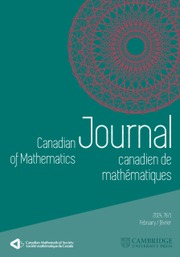Article contents
Completeness of Infinite-dimensional Lie Groups in Their Left Uniformity
Published online by Cambridge University Press: 07 January 2019
Abstract
We prove completeness for the main examples of infinite-dimensional Lie groups and some related topological groups. Consider a sequence 






















Keywords
MSC classification
Information
- Type
- Article
- Information
- Creative Commons
- This is an Open Access article, distributed under the terms of the Creative Commons Attribution licence (http://creativecommons.org/licenses/by/4.0), which permits unrestricted re-use, distribution, and reproduction in any medium, provided the original work is properly cited.
- Copyright
- © Canadian Mathematical Society 2018
References
- 1
- Cited by

